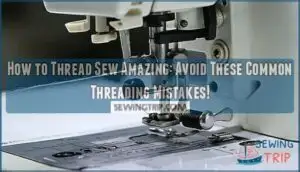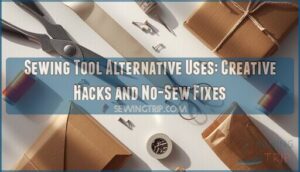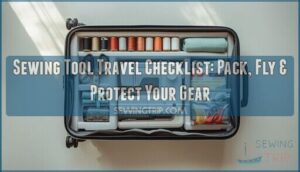This site is supported by our readers. We may earn a commission, at no cost to you, if you purchase through links.

Don’t skip the tension disks – your thread must sit snugly between those washers or you’ll get wonky stitches.
Follow every single thread guide like you’re connecting the dots; miss one and your machine throws a tantrum.
Thread through the take-up lever from left to right – think of it as giving your machine a proper handshake.
These basics seem simple, but they’re the difference between smooth sailing and a threading nightmare that makes you question your sanity.
Table Of Contents
Key Takeaways
- You must thread your machine with the presser foot raised to fully engage the tension disks – they can’t control thread flow if you skip this step
- You can’t bypass any thread guides or tension disks without causing skipped stitches, thread breaks, and looping problems that’ll ruin your project
- You need to thread the take-up lever from left to right like you’re giving your machine a proper handshake for smooth operation
- You should match your thread type to your fabric – silk for delicates, metallic for decorative work, and adjust tension settings accordingly
Not Fully Engaging The Thread Tension Disks
Your sewing machine’s tension disks act like a traffic cop for your thread, but they can’t do their job if you don’t introduce them properly. When you thread your machine, that thread must slip snugly between the tension disks – not just hover nearby like a shy party guest.
Don’t let your thread play hooky with the tension disks – proper introduction means professional results.
Thread Path Problems start when you rush through threading and miss this essential step. The thread needs to nestle completely between those metal discs, feeling their gentle squeeze. If it’s riding on top or barely touching, you’ll face Tension Disk Issues that show up as loose, loopy stitches on your fabric’s underside.
Here’s the fix: raise your presser foot first. This opens the tension disks like a door, letting your thread slide right in. Then lower the foot to engage the tension. Skip this step, and your Fabric Stitch Quality suffers with uneven, messy results.
Proper Thread Tension Adjustment depends on full disk engagement for consistent, professional-looking seams. This ensures that your sewing projects turn out with the desired quality, making Thread Path Problems a thing of the past, and resulting in seams that reflect professional-looking work, with consistent results, and a good seam.
Skipping Any Thread Guides or Tension Disks
When you bypass your sewing machine’s thread guides or tension disks, you’re asking for trouble.
These components aren’t optional – they control thread flow and prevent tension issues that lead to skipped stitches, thread breaks, and looping problems.
Think of them as traffic controllers for your thread.
Without proper threading through each guide and tension disk, your machine can’t sew amazing results.
Machine damage becomes likely when thread doesn’t follow its intended path.
Take time to thread correctly through every guide.
Regular maintenance helps prevent persistent tension issues, which can lead to persistent problems if not addressed, and ensures your machine operates smoothly, preventing thread breaks and looping problems.
Different Types of Thread and Their Uses:
Choosing the right thread can make or break your sewing project, so you’ll want to match your thread type to your fabric and purpose.
Silk thread works beautifully with delicate fabrics and hand sewing, while metallic thread adds sparkle to decorative work but needs special handling.
Silk Thread: Used for Delicate and Fine Fabrics, as Well as for Hand Sewing and Embroidery
While your machine threading works perfectly, switching to the right thread makes all the difference. Silk thread brings luxury to your sewing projects with its natural sheen and smooth texture.
Here’s your Silk Thread Properties guide:
- Superior strength – handles delicate fabrics without breaking
- Natural luster – adds elegant shine to finished seams
- Smooth texture – glides through fabric without snagging
- Fine filament – won’t weigh down lightweight materials
Your Fabric Pairing Guide starts with matching silk thread to silk, chiffon, and satin. For Hand Sewing Uses, cut 15-18 inch lengths to prevent fraying. Embroidery Applications shine with silk’s vibrant colors and dimensionality.
Because it’s made of natural silk, you can explore real silk thread options for your project. When threading your needle, silk’s slippery nature requires careful handling.
Follow your sewing machine threading guide for proper tension settings. Care Instructions recommend gentle washing to maintain thread integrity and fabric quality.
Metallic Thread: Used for Decorative Stitching and Embroidery, Adding a Shimmering Effect to The Fabric
Beyond ordinary thread lies metallic thread – your gateway to stunning decorative effects.
These shimmering strands transform plain fabric into eye-catching masterpieces through careful tension adjustment and proper needle selection. Choose size 90/14 topstitch needles for ideal fabric compatibility.
Transform plain fabric into eye-catching masterpieces with the right needle and tension settings.
Lower your sewing machine’s top tension to prevent breaks during threading. Thread breaks are a common challenge when using metallic threads.
Master these stitching techniques for flawless embroidery thread types performance, and ensure you understand how to handle thread breaks to achieve the best results.
Frequently Asked Questions (FAQs)
How do you put a thread guide on a sewing machine?
Picture Anna, a skilled seamstress who accidentally breaks her thread guide.
Thread guides simply slip onto existing metal posts near your spool holder.
Place the spool at the top, pull thread through the guide, then continue your normal threading path.
How do I know if my sewing thread is good?
Check your thread’s quality by examining its texture, strength, and appearance. Good thread feels smooth, doesn’t break easily when pulled, and has consistent color without fuzzy fibers or knots throughout.
How much thread do you need for a sewing kit?
Like a well-stocked tackle box, your sewing kit needs variety.
Start with basic colors: black, white, navy, and beige spools.
Add thread types for different fabrics—cotton, polyester, and all-purpose threads cover most projects you’ll tackle, using a variety of colors.
How to get perfect thread tension?
Turn the tension dial right for tighter stitches, left for looser ones. Test on fabric scraps first. Adjust based on your material’s weight and thickness for balanced stitches.
How to sew perfectly?
Perfect sewing starts with proper needle positioning, correct thread tension, and steady fabric feeding.
Practice consistent seam allowances, keep your machine clean, and choose quality threads.
Test settings on scraps first, maintain even stitching speed, and press seams flat to ensure steady fabric feeding is not necessary, instead the focus is on the outcome of the process.
How do you fix tangled bobbin thread?
Remove the bobbin and gently untangle the thread by hand.
Cut away severely knotted sections.
Check for thread caught in the bobbin case or tension mechanism.
Rewind the bobbin smoothly and reload it properly.
What causes skipped stitches while sewing?
Skipped stitches happen when your needle’s dull, wrong size, or bent. Check you’re using the right needle for your fabric weight. Also verify proper threading and tension settings.
How to adjust needle position correctly?
Fine-tuning your needle’s dance starts with gentle precision.
Turn the handwheel toward you to lift the needle to its highest position, then loosen the needle clamp screw.
Insert the new needle with the flat side facing away from you, pushing it up completely before tightening the clamp securely.
Why does my thread keep breaking?
Check your thread tension first – it’s likely too tight.
Also make certain you’re using the right needle size for your fabric weight, and verify your machine is threaded correctly through all guides.
How to clean lint from machine?
What’s that pesky enemy lurking in your machine’s corners?
Turn off your machine, unplug it, then open the bobbins area.
Use a small brush or tweezers to gently remove lint buildup from feed dogs, tension discs, and threading paths.
Conclusion
Threading disasters happen when you treat your sewing machine like it’s rocket science instead of remembering the basics.
Master how to thread sew amazing by following simple rules: engage those tension disks properly, hit every thread guide without exception, and thread that take-up lever correctly.
Your machine isn’t temperamental—it just demands respect for the process.
Get these fundamentals right, and you’ll transform from frustrated beginner into confident seamstress who actually enjoys threading time.
- https://www.youtube.com/watch?v=bHL2OmCZ_qw
- https://www.sewwhatbox.com/thread-a-machine
- https://www.reddit.com/r/sewing/comments/sf8fhu/need_help_threading_the_machine_its_my_first_time/
- https://www.sewingpartsonline.com/blogs/education/ultimate-thread-reference-guide-2
- https://www.mhthread.com/blog/products/types-of-sewing-thread







